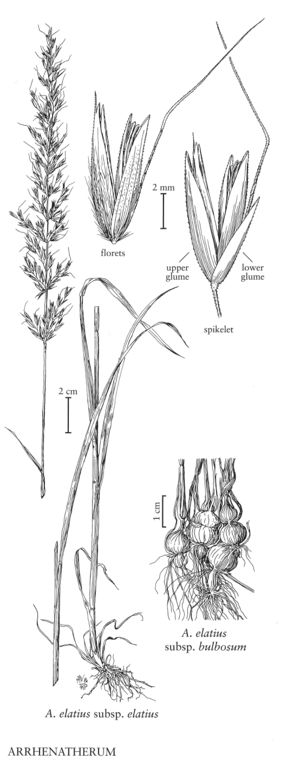Difference between revisions of "Arrhenatherum elatius"
FNA>Volume Importer |
FNA>Volume Importer |
||
| Line 23: | Line 23: | ||
-->{{Treatment/Body | -->{{Treatment/Body | ||
|distribution=Conn.;N.J.;N.Y.;Wash.;Del.;D.C;Wis.;W.Va.;Pacific Islands (Hawaii);Mass.;Maine;N.H.;R.I.;Vt.;B.C.;N.B.;Nfld. And Labr. (Labr.);N.S.;Ont.;Que.;Wyo.;N.Mex.;La.;N.C.;Nebr.;Tenn.;Pa.;Calif.;Nev.;Va.;Colo.;Md.;Alaska;Ala.;Ark.;Ill.;Ga.;Ind.;Iowa;Ariz.;Idaho;Mont.;Oreg.;Ohio;Utah;Mo.;Minn.;Mich.;Kans.;Miss.;S.Dak.;Ky. | |distribution=Conn.;N.J.;N.Y.;Wash.;Del.;D.C;Wis.;W.Va.;Pacific Islands (Hawaii);Mass.;Maine;N.H.;R.I.;Vt.;B.C.;N.B.;Nfld. And Labr. (Labr.);N.S.;Ont.;Que.;Wyo.;N.Mex.;La.;N.C.;Nebr.;Tenn.;Pa.;Calif.;Nev.;Va.;Colo.;Md.;Alaska;Ala.;Ark.;Ill.;Ga.;Ind.;Iowa;Ariz.;Idaho;Mont.;Oreg.;Ohio;Utah;Mo.;Minn.;Mich.;Kans.;Miss.;S.Dak.;Ky. | ||
| − | |discussion=<p | + | |discussion=<p>Arrhenatherum elatius is grown as a forage grass, and yields palatable hay; it does not withstand heavy grazing. It readily escapes from cultivation, and can be found in mesic to dry meadows, the edges of woods, streamsides, rock outcrops, and disturbed areas such as fields, pastures, fence rows, and roadsides. Variegated forms, with the leaves striped green and white or yellow, are cultivated as ornamentals. There are two subspecies, both of which have been found in the Flora region. Plants in which both lemmas have long, geniculate awns have been called A. elatius var. biaristatum (Peterm.) Peterm., but do not merit formal taxonomic recognition.</p><!-- |
| − | --><p | + | --><p>Arrhenatherum elatius (L.) P. Beauv. ex J. Presl & C. Presl subsp. elatius has glabrous nodes and basal internodes 2-4 mm thick. It is more common than Arrhenatherum elatius subsp. bulbosum (Willd.) Schiibl. 8c G. Martens, which has densely hairy nodes, and swollen basal internodes 5-10 mm thick. While both can be weedy, the latter subspecies is especially difficult to control in cultivated fields, as tilling the soil spreads the swollen internodes, which then propagate vegetatively.</p> |
|tables= | |tables= | ||
|references= | |references= | ||
| Line 40: | Line 40: | ||
|basionyms= | |basionyms= | ||
|family=Poaceae | |family=Poaceae | ||
| + | |illustrator=Linda A. Vorobik and Hana Pazdírková | ||
|distribution=Conn.;N.J.;N.Y.;Wash.;Del.;D.C;Wis.;W.Va.;Pacific Islands (Hawaii);Mass.;Maine;N.H.;R.I.;Vt.;B.C.;N.B.;Nfld. And Labr. (Labr.);N.S.;Ont.;Que.;Wyo.;N.Mex.;La.;N.C.;Nebr.;Tenn.;Pa.;Calif.;Nev.;Va.;Colo.;Md.;Alaska;Ala.;Ark.;Ill.;Ga.;Ind.;Iowa;Ariz.;Idaho;Mont.;Oreg.;Ohio;Utah;Mo.;Minn.;Mich.;Kans.;Miss.;S.Dak.;Ky. | |distribution=Conn.;N.J.;N.Y.;Wash.;Del.;D.C;Wis.;W.Va.;Pacific Islands (Hawaii);Mass.;Maine;N.H.;R.I.;Vt.;B.C.;N.B.;Nfld. And Labr. (Labr.);N.S.;Ont.;Que.;Wyo.;N.Mex.;La.;N.C.;Nebr.;Tenn.;Pa.;Calif.;Nev.;Va.;Colo.;Md.;Alaska;Ala.;Ark.;Ill.;Ga.;Ind.;Iowa;Ariz.;Idaho;Mont.;Oreg.;Ohio;Utah;Mo.;Minn.;Mich.;Kans.;Miss.;S.Dak.;Ky. | ||
|reference=None | |reference=None | ||
| Line 45: | Line 46: | ||
|publication year= | |publication year= | ||
|special status= | |special status= | ||
| − | |source xml=https:// | + | |source xml=https://bibilujan@bitbucket.org/aafc-mbb/fna-data-curation.git/src/314eb390f968962f596ae85f506b4b3db8683b1b/coarse_grained_fna_xml/V24/V24_1052.xml |
|subfamily=Poaceae subfam. Pooideae | |subfamily=Poaceae subfam. Pooideae | ||
|tribe=Poaceae tribe Poeae | |tribe=Poaceae tribe Poeae | ||
Revision as of 16:04, 30 October 2019
Plants loosely cespitose, sometimes rhizomatous, rhizomes to 3 mm thick. Culms 50-140 (180) cm, erect, glabrous, unbranched, basal internodes swollen or not; nodes usually glabrous, occasionally puberulent to densely hairy. Sheaths smooth; ligules 1-3 mm, obtuse to truncate, usually ciliate; blades 5-32 cm long, (1)3-8(10) mm wide, flat, usually glabrous, rarely shortly pilose, sometimes scabrous. Panicles 7-30(36) cm long, 1-6(10) cm wide, green, shiny, becoming stramineous, sometimes purple-tinged; branches 15-20 mm, ascending to divergent, verticillate, usually spikelet-bearing to the base; pedicels 1-10 mm. Spikelets 7-11 mm; rachillas stout, internodes to 0.7 mm, prolongations 1.2-2 mm, slender, apices often with a small, club-shaped rudiment. Glumes lanceolate to elliptic; lower glumes 4-7 mm; upper glumes 7-10 mm; callus hairs to 3.7 mm; lemmas (4)7-10 mm, apices bifid; awns of lower lemmas 10-20 mm, twisted below, often with alternating light and dark bands; awns of upper lemmas absent or to 5 mm and arising just below the apices, rarely to 15 mm and arising from above the middle; paleas 0.5-1 mm shorter than the lemmas, acute; anthers 3.6-5(6) mm. Caryopses 4-5 mm long, about 1.2 mm wide, ellipsoid, densely hairy, yellowish. 2n = 14, 28, 42.
Distribution
Conn., N.J., N.Y., Wash., Del., D.C, Wis., W.Va., Pacific Islands (Hawaii), Mass., Maine, N.H., R.I., Vt., B.C., N.B., Nfld. And Labr. (Labr.), N.S., Ont., Que., Wyo., N.Mex., La., N.C., Nebr., Tenn., Pa., Calif., Nev., Va., Colo., Md., Alaska, Ala., Ark., Ill., Ga., Ind., Iowa, Ariz., Idaho, Mont., Oreg., Ohio, Utah, Mo., Minn., Mich., Kans., Miss., S.Dak., Ky.
Discussion
Arrhenatherum elatius is grown as a forage grass, and yields palatable hay; it does not withstand heavy grazing. It readily escapes from cultivation, and can be found in mesic to dry meadows, the edges of woods, streamsides, rock outcrops, and disturbed areas such as fields, pastures, fence rows, and roadsides. Variegated forms, with the leaves striped green and white or yellow, are cultivated as ornamentals. There are two subspecies, both of which have been found in the Flora region. Plants in which both lemmas have long, geniculate awns have been called A. elatius var. biaristatum (Peterm.) Peterm., but do not merit formal taxonomic recognition.
Arrhenatherum elatius (L.) P. Beauv. ex J. Presl & C. Presl subsp. elatius has glabrous nodes and basal internodes 2-4 mm thick. It is more common than Arrhenatherum elatius subsp. bulbosum (Willd.) Schiibl. 8c G. Martens, which has densely hairy nodes, and swollen basal internodes 5-10 mm thick. While both can be weedy, the latter subspecies is especially difficult to control in cultivated fields, as tilling the soil spreads the swollen internodes, which then propagate vegetatively.
Selected References
None.
